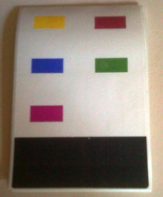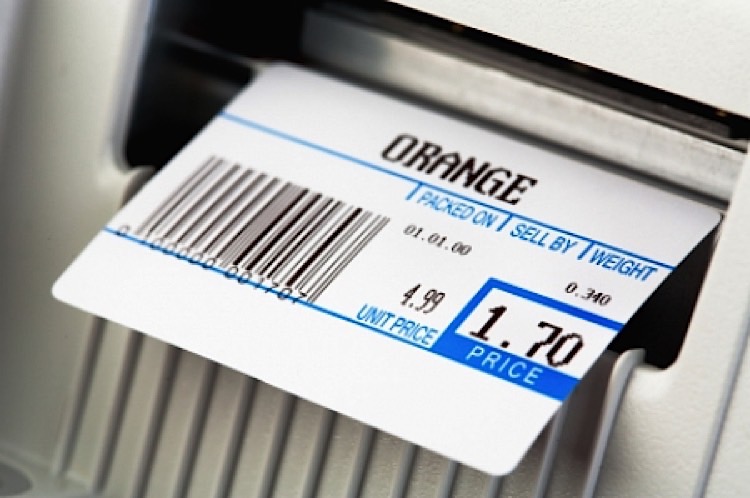The title of this article sounds impossible. Why or how in the world would companies be able to print multi-color thermal labels on equipment that was designed for black, monochrome direct thermal printing? And is this printing technology viable? Let’s take a look at direct thermal printing and this new printing technology.
2-Color Labels Required
I must confess: the technology I will outline today has been on the market since 2009. I was not made aware of it until about 6 months ago when I received a call from a company in the JCPenney distribution channel. This company had a requirement for some “standard” direct thermal UPC tags, except that these tags had a red price box at the bottom. They needed to duplicate the 2 color labels, and wanted to use their existing direct thermal label printers.
I had previously written a brief article about the differences between thermal transfer and direct thermal label printers. Essentially, thermal transfer is used when durability, longevity, and non-direct thermal material is required, or when a color instead of black is desired. While direct thermal technology has improved the past few years, it still is NOT the best solution for applications requiring the parameters just mentioned.
Direct Thermal Printing Explained
Direct thermal printing has been around for a long time. Most of us still can remember our first fax machine, and loading the direct thermal paper rolls. The legibility wasn’t always the best, and we learned that a fingernail could easily scratch the paper. Direct thermal papers, and now direct thermal films, are essentially created by laying down a black coating on the white paper. This coating is then covered over with a layer of tiny white “bubbles.” When the heat from the printhead activates or heats certain areas, those areas of “bubbles” essentially burst, leaving behind the black background. This is why direct thermal materials are easily scratched—the top layer bursts, revealing the black layer. Over time, the materials will turn black, the printing will fade, and more “bubbles” will burst—particularly when activated by any type of heat or the sun.
Newer Direct Thermal Label Materials
I had previously suggested that direct thermal papers would be ok for applications requiring up to 1 year, maybe 2 years longevity, if not stored in the heat or sunlight. This prompted a few phone calls from direct thermal paper manufacturers, explaining that improvements have been made and longevity is much longer. They also spoke about their newer direct thermal FILM offerings. While I agree that advancements have been made, direct thermal materials still have their place, whereas thermal transfer materials do as well. As a general rule, for high volume applications, direct thermal is overall less expensive than thermal transfer due to not having to purchase thermal transfer ribbons.
While some direct thermal films are now available, these are mainly used for applications involving a lot of moisture, where paper will not hold up. Note that this is different than “durable” label films that can last for over 10 years. For example, asset or equipment tags are a better fit for thermal transfer, even when a direct thermal film is considered. Also note that one direct thermal paper rep suggested using a clear lamination to increase durability and longevity—but at that price point, and extra lamination step, the easier and less expensive solution was thermal transfer.
Color Capable Label Printer Material
While researching the new color capable direct thermal materials, I spoke with both Zebra and Epson America. While Zebra markets SPECIAL MEDIA to achieve this, EPSON markets a retail printer, and doesn’t really mention the media. When I asked the Epson support person how this technology works, he said he didn’t know; at that point I suggested that perhaps it was just “magic.” Zebra told me that the trick with this new technology is that the colored areas on the label would need to be PRE-DETERMINED. For some reason it had taken 2 weeks for me quote request and another 2 weeks to receive a couple of samples. As soon as I received the samples I could tell how the “magic” occurred.
The Magic Revealed-How It Works
The “trick” isn’t in the printer or material at all. Instead a transparent ink, suitable for flexographic label presses, is pre-printed onto the labels, and when passed through the print head, the clear ink areas image in color instead of black. So for the application I was working on, there needed to be a small square box at the bottom of the label, preprinted with the transparent ink, so that when printed with the printhead’s heat, any thermal printing in that box would image the price in red. So, this explains why Epson’s stock media allows for 2 color printing; but the red printing can only occur where they have pre-printed that particular area.
 Color is not limited to red; the chemical composition of these thermo-chromatic inks can also image, blue, green, and yellow. So the magic is simply a thermo-chromatic ink, which will image in a pre-specified color; the final color depends on the chemical components. So in the picture example to the right, the black at the bottom is standard; no ink is required as a background, and each color, or symbol, is printed over top of the clear ink. Any heat that is applied to the top right area will image as red; any heat applied to the left center block will image as blue, etc.
Color is not limited to red; the chemical composition of these thermo-chromatic inks can also image, blue, green, and yellow. So the magic is simply a thermo-chromatic ink, which will image in a pre-specified color; the final color depends on the chemical components. So in the picture example to the right, the black at the bottom is standard; no ink is required as a background, and each color, or symbol, is printed over top of the clear ink. Any heat that is applied to the top right area will image as red; any heat applied to the left center block will image as blue, etc.
Is This Technology Viable?
So that is how the technology works, but it is viable or affordable? I’ve found that for small quantities of 5,000 or 10,000 labels, the label price is an obstacle in a lot of cases. This technology is a good fit with large runs, where the predetermined colors are consistent. For example, a run of 500,000 labels, where the red box is always in the exact same location may make sense. But then again, when we look at the final numbers, perhaps pre-printed thermal transfer makes more sense. The main difference? For applications that require some color, if the colored fields (locations on the label) will be imprinted with variable information, then direct thermal pre-printing may make sense; for applications requiring the same colored border on every label, thermal transfer may end up making more sense due to less expensive inks, transfer paper material, and press-time overhead. In this case the end user could purchase labels with a pre-printed colored border or logo, then imprint in black.
Direct thermal technologies will continue to evolve, and their price will most likely fall. While color direct thermal printing may not be the best application to replace existing methods and tools, they do provide a viable option for some.
Published:


